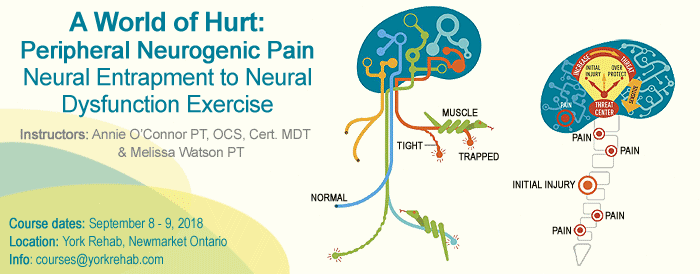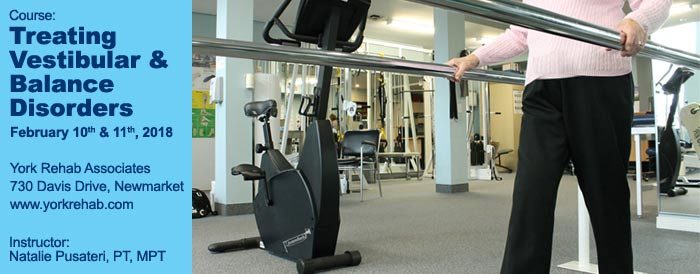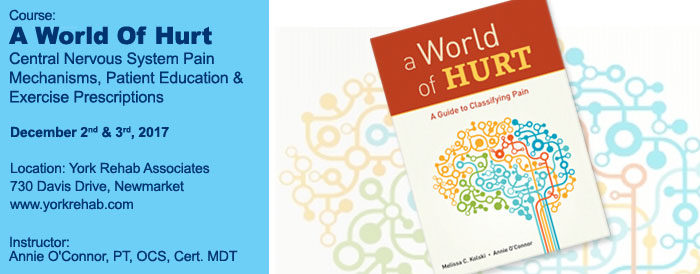Courses & Training
WoH: Peripheral Neurogenic Pain (course)
Course: September 8-9, 2018
A World of Hurt: Peripheral Neurogenic Pain Neural Entrapment to Neural Dysfunction Exercise Prescriptions
Download registration form and payment instructions.
COURSE DESCRIPTION
This two-day course focuses information critical to the assessment and treatment of patients dominated by Nociceptive Pain Mechanisms involving the peripheral nerve. The Peripheral Neurogenic Pain Mechanism (PNPM) requires specific neurodynamic mechanical exercise prescriptions as well as pain science education about peripheral nerves and the pain alarm system. Outlining Chapter Five and Six of “A World of Hurt: A Guide to Classifying Pain,” pain clinicians will learn how to assess and classify neurogenic nociceptive pain mechanisms as either “trapped,” “tight,” or “sensitive” utilizing neurodynamic evaluation testing and clinical reasoning. This course assists identifying neural entrapments, dysfunctions and/or the beginning signs of central sensitivity in both the upper, lower body and spine. This pain science course provides interventions in patient education for neurogenic conditions and specific prescriptive neurodynamic exercises for each neurogenic mechanical problem. This course includes an active manual therapy workshop for common upper and lower body neural entrapment sites and local tissue treatments. The workshop is dedicated to both active neurodynamic exercise progression and passive neurodynamic testing, in addition to manual therapy. Video, paper cases and live patient demonstrations (when available) will aid application to each clinician’s practice by understanding the importance of the specific “words” and “moves” necessary to reverse neurogenic mechanical nociceptive pain mechanisms.
WHO SHOULD ATTEND
Physical and Occupational Therapists, Chiropractors, Osteopaths, Physical Therapist Assistants, Occupational Therapy Assistants, Medical Doctors, Psychologists, Athletic Trainers, Massage Therapists, Personal Trainers, and any other practitioners who are involved in treating musculoskeletal pain and prescribing exercise.
COURSE OBJECTIVES
At the conclusion of this course, participants should be able to:
- Differentiate subjective and objective clinical characteristics in peripheral neurogenic and central sensitivity pain mechanisms.
- Differentiate subjective and objective clinical characteristics for mechanical syndromes of the nervous system including neural entrapments, neural dysfunction and central sensitivity.
- Prescribe patient education and exercise interventions for mechanical syndromes related to neural entrapments, neural dysfunction in spine, upper and lower extremities.
- Perform passive repeated movement neurodynamic evaluation and treatment for common upper and lower extremity peripheral nerves.
- Classify the dominant pain mechanism and prescribe patient education and active care intervention to paper, video and live patient demonstrations.
- Demonstrate common manual therapy techniques for upper and lower extremity entrapment sites.
Course Fee: (Canadian dollars)
$550.00 (early registration received on/before July 31, 2018)
$600.00 (registration received on/before August 23, 2018)
FACULTY (Course Instructors)
Annie O’Connor, PT, OCS, Cert. MDT, is Corporate Director of the Musculoskeletal Practice and Clinical Manager of the River Forest Outpatient Center at the Shirley Ryan Ability Lab formerly known as the Rehabilitation Institute of Chicago. Annie has co-authored 2018, Pain Mechanism Classification Chapter, Rehabilitation of The Spine: A Patient Center Approach, Liebenson C (3 ed). Wolters Kluwer Philadelphia publisher. She has co-authored 2017, Therapeutic Exercise Chapter, Orthopedic Knowledge Update Spine 5, American Academy for Orthopedic Surgeons publisher. This chapter specifically is dedicated to helping Medical Doctors understand pain mechanism classification and the importance in therapeutic exercise selection. She has co-authored 2015 book “A World of Hurt: A Guide to Classifying Pain” and September 2016 Journal Article in JMMT “Validation of a pain mechanism classification system (PMCS) in physical therapy practice.” Both publications offer a research supported “paradigm shift” in managing Musculoskeletal Pain promoting effective and efficient outcomes with significant cost savings. She is an Orthopedic Clinical Specialist (OCS) of the American Physical Therapy Association and has a Certification in Mechanical Diagnosis and Therapy in the McKenzie Method (Cert. MDT). She lectures nationally and internationally on musculoskeletal pain mechanism classification and intervention, neurodynamic evaluation and treatment, mechanical diagnosis and therapy of spine and extremities, kinetic chain evaluation, functional manual therapy and exercise prescription. She was instrumental in establishing the Pain Mechanism Classification System approach for musculoskeletal pain at the Shirley Ryan Ability Lab formerly known as the Rehabilitation Institute of Chicago. She is a member of American Physical Therapy Association in the orthopedic section and canine special interest group, the North American Spine Society (NASS), and McKenzie Institute. She serves on the 10X25 tactile coalition task force to reduce spine related disability by 10% in year 2025 sponsored by the Spine Foundation a national group of the NASS. She continues to treat orthopedic, neurological patients, and canines with musculoskeletal pain to achieve the best life possible.
Melissa Watson, MSPT, Cert. MDT, received her Master’s in Physical Therapy and her Bachelor’s in Exercise Physiology from Ohio University. Melissa practices at the Shirley Ryan Ability Lab formerly known as the Rehabilitation Institute of Chicago Willowbrook Outpatient Center with 16 years of clinical experience in neurological rehabilitation. Melissa has been helping to lead RIC’s Clinical Ladder Program for over 7 years where she mentors other clinicians on their professional and clinical development. She is a certified clinical instructor and consistently mentors students in clinical practice. She is practicing clinically in the Day Rehabilitation setting with an interest in musculoskeletal pain and applying both MDT and pain classification principles within the neurological population for pain and spasticity. She is currently leading a Day Rehab Pain Group Committee where she is mentoring other Day Rehab clinicians on running pain groups that are focusing on pain education and active care treatment for patients with centrally dominated pain throughout 6 sites of care and facilitating a standard for education through Inpatient clinicians. She is certified in Mechanical Diagnosis and Treatment – McKenzie Method. She has been training the Pain Mechanism Classification System outlined in the book “A World of Hurt: A Guide to Classifying Pain” for last 3 years and uses both sub grouping methods exclusively in her neurological clinical practice to guide patient education and exercise prescription to facilitate functional return.
Disclosures
Financial: The presenters will receive an honorarium and expenses for teaching this course.
Nonfinancial: The presenters have no relevant financial relationships to disclose.
Course Book: “A World of Hurt: A Guide to Classifying Pain”
References:
- Kolski M, O’Connor A. World of Hurt: A Guide to Classifying Pain, Chapters 1-8. Thomasland Publishers Inc, 2015
- Kolski M, OConnor A, VanDerlaan K, Jungwha A, Koslowski A, Deutch A. (2016) Validation of a pain mechanism classification system (PMCS) in physical therapy practice. Journal of Manual and Manipulative Therapy; 08 September, 1-8.
- Smart KM, Curley A, Blake C, Staines A, Doody C. (2010) The reliability of clinical judgments and criteria associated with mechanisms-based classifications of pain in patients with low back pain disorders: a preliminary reliability study. Journal of Manual and Manipulative Therapy, Volume 18, No. 2: 102-110.
- Smart KM, Blake C, Staines A, Doody C. (2010) Clinical indicators of ‘nociceptive’, ‘peripheral neuropathic’ and ‘central’ mechanisms of musculoskeletal pain. A Delphi survey of expert clinicians. Manual Therapy; 15:80-87.
- Smart, K., Blake, C., Staines, A., & Doody, C. (2011) The Discriminative validity of “nociceptive”, “peripheral neuropathic”, and “central sensitization” as mechanisms-based classifications of musculoskeletal pain. Clin J Pain; 27(8), 655-663.
- Donelson R, Long A, Spratt K, Fung T. Influence of directional preference on two clinical dichotomies: acute versus chronic pain and axial low back pain versus sciatica. Physical Medicine & Rehabilitation. 2012;In press.
- Doth AH, Hansson PT, Jensen MP, Taylor RS (2010). The burden of neuropathic pain: a systematic review and meta-analysis of health utilities. Pain, 149:338-344.
- Kleinman, N; Patel, A; Benson, C; Macario, A; Kim, M; Biondi, D (2014). “Economic Burden of Back and Neck Pain: Effect of a Neuropathic Compnent.” Population Health Management Volume 0, Number 0, DOI: 10.1089/pop.2013.0071
- Schmid AB, Nee RJ, Coppetiers MW. (2013) Reappraising Entrapment Neuropathies- Mechanisms, diagnosis and management. Manual Therapy (18), 459-457.
- Nee, R. J., C. H. Yang, et al. (2010). “Impact of order of movement on nerve strain and longitudinal excursion. A biomechanical study with implications for neurodynamic testing.” Manual Therapy (on-line).
- Saban B, Deutscher D, Tomer Z. (2013) Deep massage to posterior calf muscles in combination with neural mobilization exercises as a treatment for heal pain: A pilot randomized clinical trial . Manual Therapy (on-line).
- Thomes EJ, et al. (2013) The effectiveness of conservative treatment of patients with cervical radiculopathy. A Systemic Review. Clin J Pain, Volume 29, Number 12, 1073-1087.
- Moriarty O, et al. (2011) The Effect of Pain on Cognitive Function: A review of clinical and pre-clinical research. Progress in Neurobiology 93, 385-404.
Treating Vestibular & Balance Disorders (Course: Feb 10-11)
Treating Vestibular & Balance Disorders (2-Day Course)
Dates: February 10th and 11th, 2018
Location: York Rehab Associates, 730 Davis Drive, Newmarket, ON. L3Y 2R4
Course Purpose: To familiarize clinicians with vestibular and non-vestibular causes of imbalance and dizziness and to learn how to assess and treat these dysfunctions. This course is appropriate for (but not limited to) any physiotherapist/assistant treating MSK (trauma, orthopedic…), ABI geriatrics, SCI, Stroke, Long Term Care.
Instructor: Natalie Pusateri, MPT has been a physiotherapist for more than 15 years and has a national certification in treating vestibular disorders. She has dedicated her career to treating those with dizziness and imbalance as well as the neurologically impaired community, sitting on several boards and obtaining additional specialties in the areas of Parkinson’s, amputees, and MS.
In addition to patient care, Natalie has devoted time to educating both the public and her peers. She has spent the last decade speaking everywhere from senior groups to the American Physical Therapy Association on the topics vestibular disorders and balance as well as preventing falls in the elderly.
She also traveled the United States providing a 2 day course on treating balance and vestibular disorders. With her move from St. Louis in 2010, Natalie brought her passion for serving this need in the population to Toronto. She is now working at both University of Toronto and Toronto Rehabilitation. She continues to give courses on treating balance and vestibular disorders throughout the GTA.
Course Fee: $350+HST= $395.50 (includes lunch)
Payable by cheque to York Rehab / Call for phone payment: (905) 715 7201
Fax Registration form to: (905) 715 7037
Cancellation Policy: Until Jan. 10th, 2018 – full refund less $25 administration fee.
Course: World of Hurt (Dec 2 & 3, 2017)
Course:
A World Of Hurt: Central Nervous System Pain Mechanisms, Patient Education & Exercise Prescriptions. Course outline is available here.
– LIVE patient demos will be included
Who should attend:
This course will benefit any healthcare provider working with patients dominated by Central Nervous System (CNS) Pain Mechanisms. Strategies to sub-group patients within this classification will be provided to allow for targeted treatment
Instructor:
Annie O’Connor, PT, OCS, Cert. MDT
Rehabilitation Institute of Chicago
Biography included within attached course outline.
When: Dec 2nd – 3rd, 2017
Time: Day #1 = 8:00 am – 5:30 pm / Day #2 = 8:00 am – 4:45 pm
Location:
York Rehab Associates
730 Davis Drive (Unit #1), Newmarket, ON, L3Y 2R4
Cost: Early bird rates apply!
$550.00 (up to and including Oct/31st/17)
$600.00 (up to and including Nov/17th/17)
– Inclusive of course instruction, manual, textbook and meals
– Textbook: A World Of Hurt: A Guide To Classifying Pain
Payment Methods:
– Cash / cheque* / debit / VISA / MasterCard
* Please make cheques payable to ‘York Rehab’
– AMEX not accepted
Registration Deadline: Nov 17th 2017
Course Coordinator:
Name: Fiona MacKenzie PT, Dip. MDT
Tel: 905-715-7201
Email: fmackenzie@yorkrehab.com




